
OUR TOP FOUR FAVORITE TRANSPLANT VARIETIES WE'RE GROWING THIS SPRING
03/01/19 — Heydon Hatcher
We’ve got the Transplant Sale on our minds as the second weekend of the three-weekend event quickly approaches. We have a vast spread of crop varieties available to you this year, a selection that we continue to diversify over the years.
Why do we offer and grow so many different varieties of crops here at JBG, you might wonder? Seed variety and seed preservation are important because of the trend to seed domesticate, or in other words, select seeds that are advantageous to humans, but simultaneously dwindle and simplify crop variety banks over the years. This practice has put us in danger for many reasons, but the main one being (in the words of J. Ray): “ Varietal decline threatens agrodiversity. We know this—the less biodiverse any system is, the greater the potential for its collapse. In shriveling the gene pool both through loss of varieties and through the industrial takeover of an evolutionary process, we strip our crops of the ability to adapt to change and we put the entire food supply at risk. The more food varieties we lose, the closer we slide to the tipping point of disaster.” Thus, seed variety/preservation is not only delicious on our plates but integral equally to our future and agricultural survival. So, get to farming, folks, and grab some of those Ark of Taste varieties to expand our horticultural horizons and ensure a future for those at-risk crops facing extinction!
We also spend ample time poring over seed catalogs in order to select the crops most suited for our Central Texas soil and climate. This is all in an attempt to set your backyard garden aspirations up for success in the coming months. We will additionally be offering a Gardening Workshop (in conjunction with this Saturday's (3/2) Transplant Sale) with farming master and our farm manager, Becky, just in case you want to brush up on some farming pro-tips. So, don't dally, grab your tickets here and expand your gardening know-how ASAP! Just in case you need some ideas for your garden, scroll down for some of our favorite varieties.
![]() First weekend of the transplant sale. Photo by Scott David Gordon.
First weekend of the transplant sale. Photo by Scott David Gordon.
![]() Holy Basil flowering. Photo courtesy of Eat Your Yard Jax.
Holy Basil flowering. Photo courtesy of Eat Your Yard Jax.
![]() Sungold tomatoes. Photo courtesy of Bonnie's Plants.
Sungold tomatoes. Photo courtesy of Bonnie's Plants.
![]() Kale fields! Photo by Scott David Gordon.
Kale fields! Photo by Scott David Gordon.
![]() Lunchbox peppers. Photo courtesy of Johnny's Selected Seeds.
Lunchbox peppers. Photo courtesy of Johnny's Selected Seeds.
Peruse our vast menu of transplants online! And perhaps visit our Greenhouse sale! We can’t wait.
Why do we offer and grow so many different varieties of crops here at JBG, you might wonder? Seed variety and seed preservation are important because of the trend to seed domesticate, or in other words, select seeds that are advantageous to humans, but simultaneously dwindle and simplify crop variety banks over the years. This practice has put us in danger for many reasons, but the main one being (in the words of J. Ray): “ Varietal decline threatens agrodiversity. We know this—the less biodiverse any system is, the greater the potential for its collapse. In shriveling the gene pool both through loss of varieties and through the industrial takeover of an evolutionary process, we strip our crops of the ability to adapt to change and we put the entire food supply at risk. The more food varieties we lose, the closer we slide to the tipping point of disaster.” Thus, seed variety/preservation is not only delicious on our plates but integral equally to our future and agricultural survival. So, get to farming, folks, and grab some of those Ark of Taste varieties to expand our horticultural horizons and ensure a future for those at-risk crops facing extinction!
We also spend ample time poring over seed catalogs in order to select the crops most suited for our Central Texas soil and climate. This is all in an attempt to set your backyard garden aspirations up for success in the coming months. We will additionally be offering a Gardening Workshop (in conjunction with this Saturday's (3/2) Transplant Sale) with farming master and our farm manager, Becky, just in case you want to brush up on some farming pro-tips. So, don't dally, grab your tickets here and expand your gardening know-how ASAP! Just in case you need some ideas for your garden, scroll down for some of our favorite varieties.
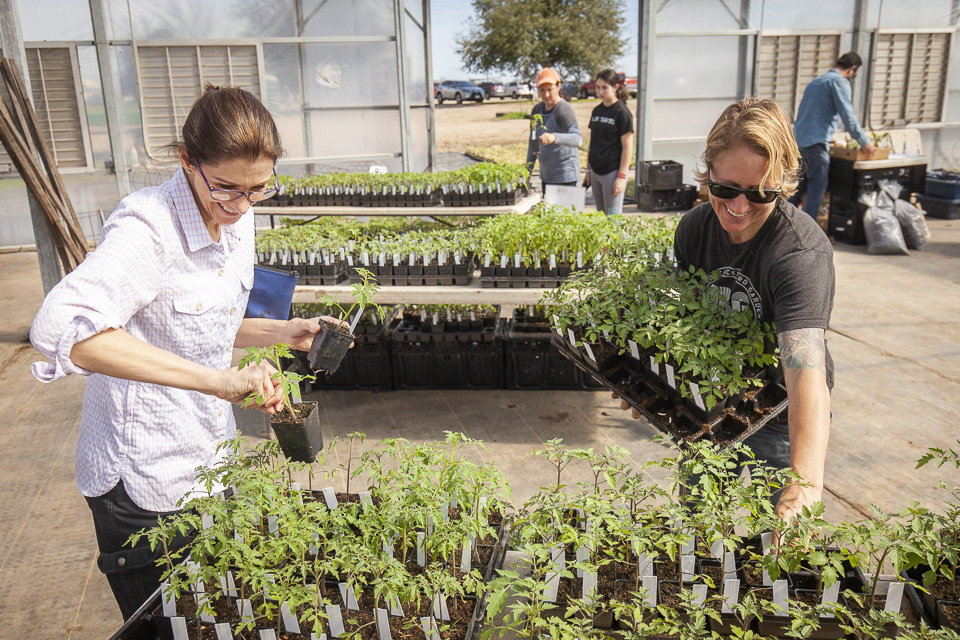 First weekend of the transplant sale. Photo by Scott David Gordon.
First weekend of the transplant sale. Photo by Scott David Gordon.
Here are the top four favorite varieties we’re growing this spring:
Holy Basil
Basil is always a crowd favorite, and this year we decided to cultivate 5 varieties of it. Holy Basil, otherwise known as Tulsi, hails from India and has been traditionally used as a medicinal herb. Vastly integral in Hindu worship and the Ayurvedic school of medicine, this herb has been thought to heal a gamut of ailments such as heart disease, upset stomach, asthma, and day-to-day anxiety. Dry the leaves and use it in tea, or throw the leaves into your next stir-fry for a peppery taste. This wonder herb has innate insect repellent qualities, and because of its anti-inflammatory properties, can also be used as a salve for snake and scorpion bites.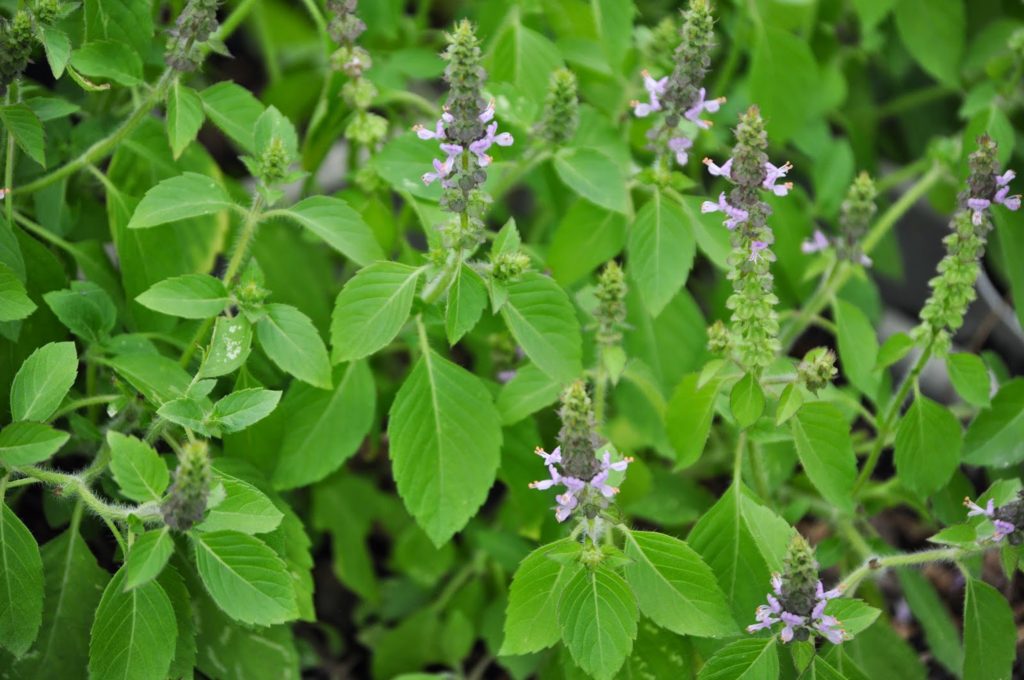 Holy Basil flowering. Photo courtesy of Eat Your Yard Jax.
Holy Basil flowering. Photo courtesy of Eat Your Yard Jax.
Sungold Tomatoes
Tomatoes are essential to a bonafide summertime backyard garden, and this year we are offering around 18 different types. The Sungold is one of our more beloved nightshades. With its saccharine sweet taste and compact size, this is sure to be a family favorite. You don’t even need to cook these ‘maters, pop ‘em in your mouth as a snack or toss ‘em into your salad. These fruits thrive in the heat and will grow in clusters, so make sure to stake this crop. We'll be selling cages at the sale, so you don't have to worry about additional supplies!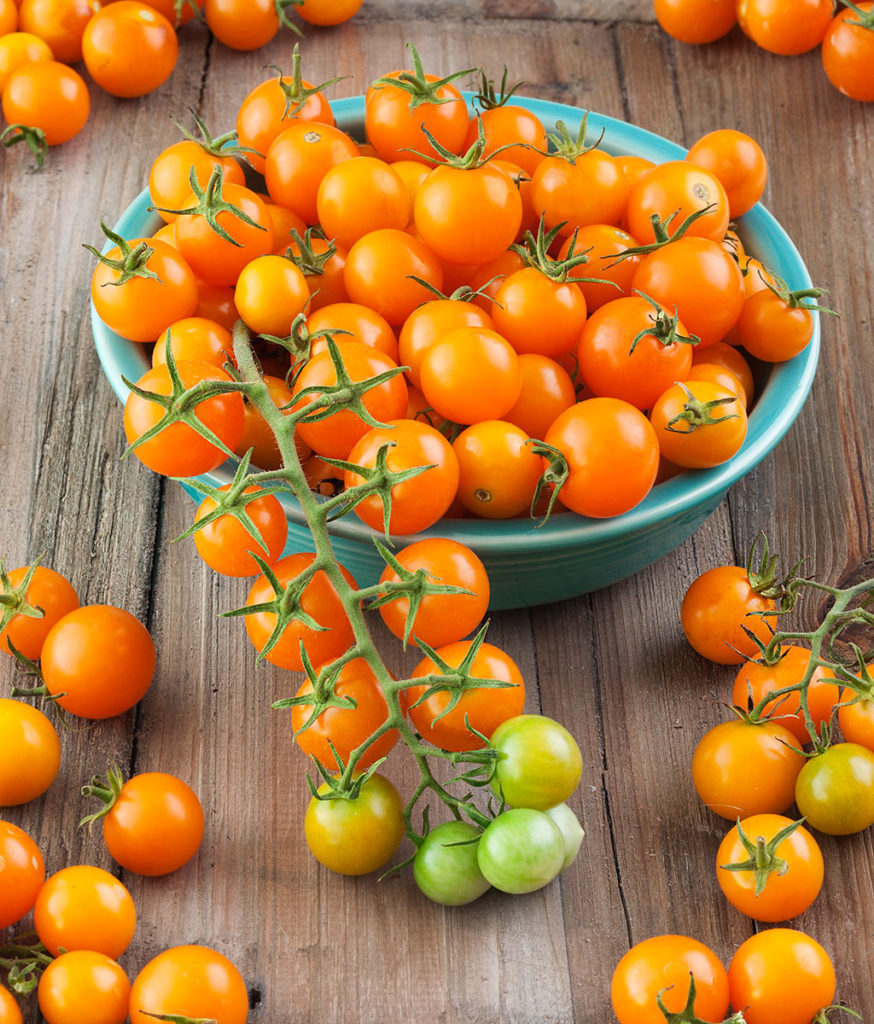 Sungold tomatoes. Photo courtesy of Bonnie's Plants.
Sungold tomatoes. Photo courtesy of Bonnie's Plants.
Winterbor Kale
This frilly, almost blue in hue, leafy green is not only delectable but an absolutely beautiful sight out in the fields. This kale’s dense leaves paired with a mildly sweet flavor is perfect for smoothies, salads, and wraps. Plus, it’s a rich source of vitamin K, A, C, and B6! Cold-tolerant and extremely hearty, this is sure to be the green to jumpstart your green-thumb tendencies.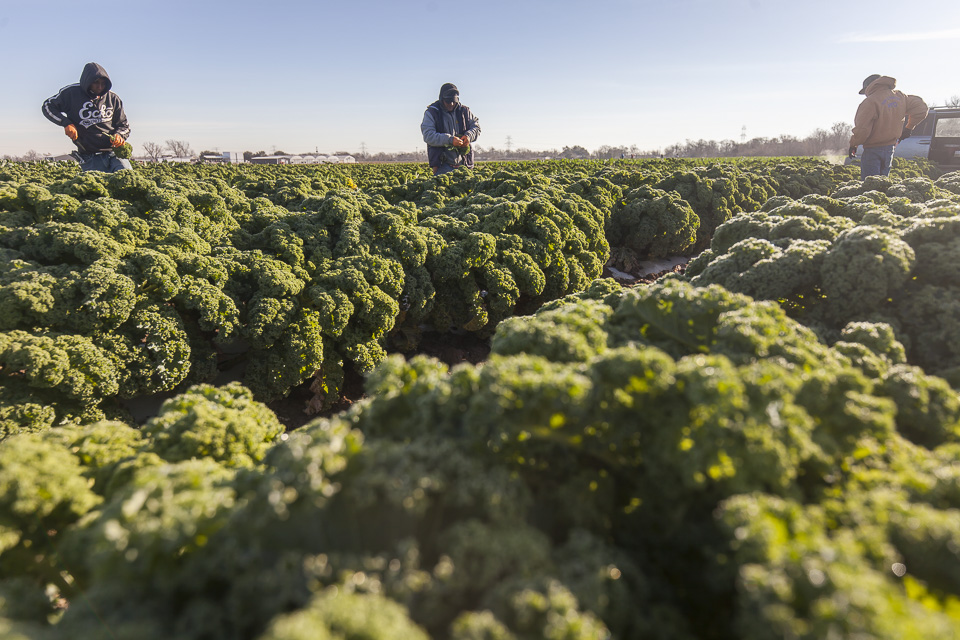 Kale fields! Photo by Scott David Gordon.
Kale fields! Photo by Scott David Gordon.
Lunchbox Pepper
This pepper is exceptionally sweet and grows in a dazzling mixture of red, yellow, or orange. Its miniature size is irresistible, and might potentially be your kiddos gateway veggie to a world of healthy snacking. Not into snacking raw vegetables? Don’t fret, these nightshades shine as a sauteed side plate or thrown on a salad for that sweet pop.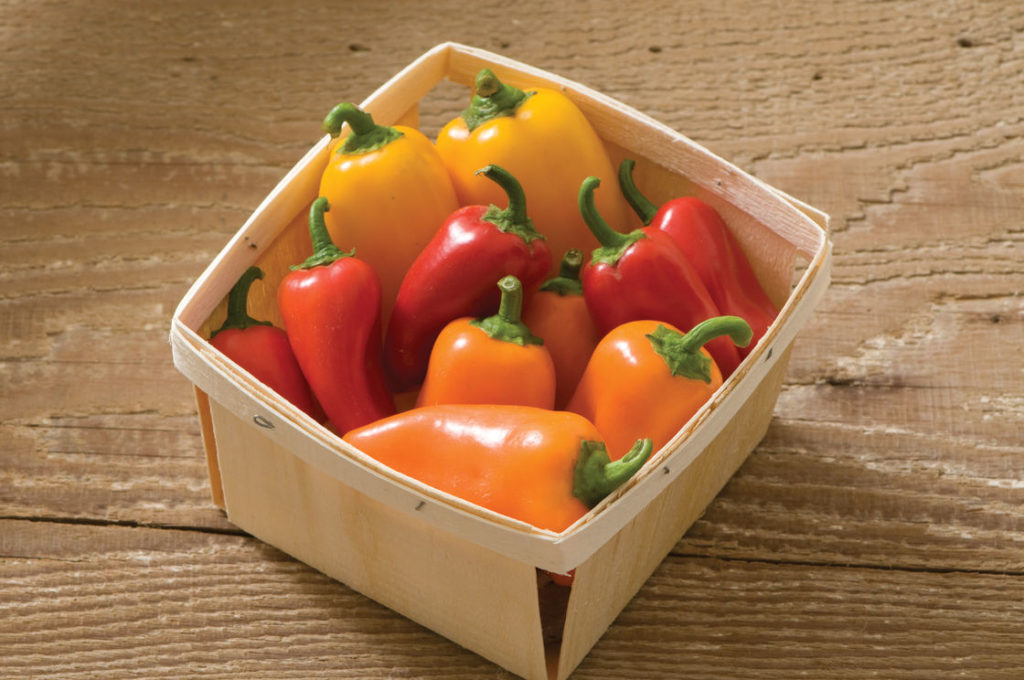 Lunchbox peppers. Photo courtesy of Johnny's Selected Seeds.
Lunchbox peppers. Photo courtesy of Johnny's Selected Seeds.
Peruse our vast menu of transplants online! And perhaps visit our Greenhouse sale! We can’t wait.
LOW CARB CHARD ENCHILADAS
02/28/19 — Heydon Hatcher
Author and Photographer: The Migoni Kitchen / Servings: 4 People / Total Time: 40 minutes
Chard is officially in season! The leaves are huge and beautiful, so we thought they’d be perfect to create some type of rolls. Living in Texas, of course, the idea of low-carb enchiladas came to mind and we ran with it. They have got to be one of our favorite healthy recipes we’ve made in a long time! It’s not often that you can make a truly healthy, low-carb dish that doesn’t sacrifice on the taste factor, but these enchiladas deliver.
![]()
The chard works wonderfully because it’s sturdier than most other greens. So sturdy, in fact, that we do recommend blanching the leaves before filling them, as they are hard to roll if you don’t. We even kept the stems of the chard, dicing them up finely and adding them to the filling! We didn’t notice them at all, plus less waste!
![]()
Cut the stems off your chard leaves, dice them and set them aside. We will be cooking these with the filling.
Blanch each leaf for 1-2 seconds in the boiling water and place into the ice bath. Blanching the leaves helps to make them easier to roll.
Next, make the enchilada sauce. Add the diced tomatoes, tomato sauce, chipotle chilies with some of the chipotle sauce, and 1 garlic clove to a food processor or blender. Pulse until smooth. Add salt and pepper to taste and set aside.
Preheat oven to 350F
Add 1 tablespoon olive oil to a large saucepan over medium heat.
Add the onions, jalapenos, and 2 cloves garlic. Let cook for about 2-3 minutes or until softened.
Add the ground beef next, using the back of a wooden spoon to break it up and brown.
Once the meat has cooked through, add in the diced chard stems, and the spices - paprika, cumin, oregano, cayenne, and about 1 teaspoon of salt. Stir to combine.
Next, add in about 4 tablespoons of the sauce you had set aside and combine well. Cook for about 5-7 minutes and then remove from heat.
Add 3-4 tablespoons of your sauce to the bottom of a baking dish (we used an 8.5" by 11" dish) to prevent sticking.
Add a few spoonfuls (amount will vary depending on the size of your leaves) of filling to the center of your chard leaf. Fold in the sides and gently roll up, like a burrito. Place into baking dish. Continue until you have used all of your leaves.
Pour remaining sauce over the top and bake at 350F for about 10 minutes.
![]()
Remove enchiladas from the oven and top with your cotija cheese or queso fresco and bake for another 10 minutes.
Top with fresh cilantro and any other of your favorite toppings such as sour cream, avocado, and sliced jalapenos!
Chard is officially in season! The leaves are huge and beautiful, so we thought they’d be perfect to create some type of rolls. Living in Texas, of course, the idea of low-carb enchiladas came to mind and we ran with it. They have got to be one of our favorite healthy recipes we’ve made in a long time! It’s not often that you can make a truly healthy, low-carb dish that doesn’t sacrifice on the taste factor, but these enchiladas deliver.
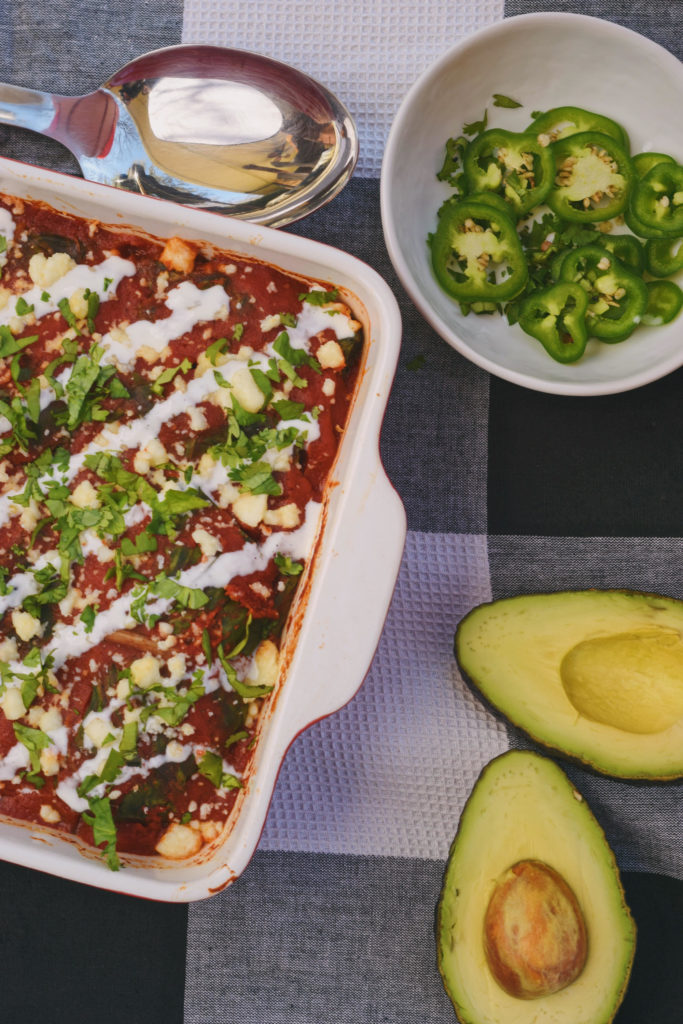
The chard works wonderfully because it’s sturdier than most other greens. So sturdy, in fact, that we do recommend blanching the leaves before filling them, as they are hard to roll if you don’t. We even kept the stems of the chard, dicing them up finely and adding them to the filling! We didn’t notice them at all, plus less waste!
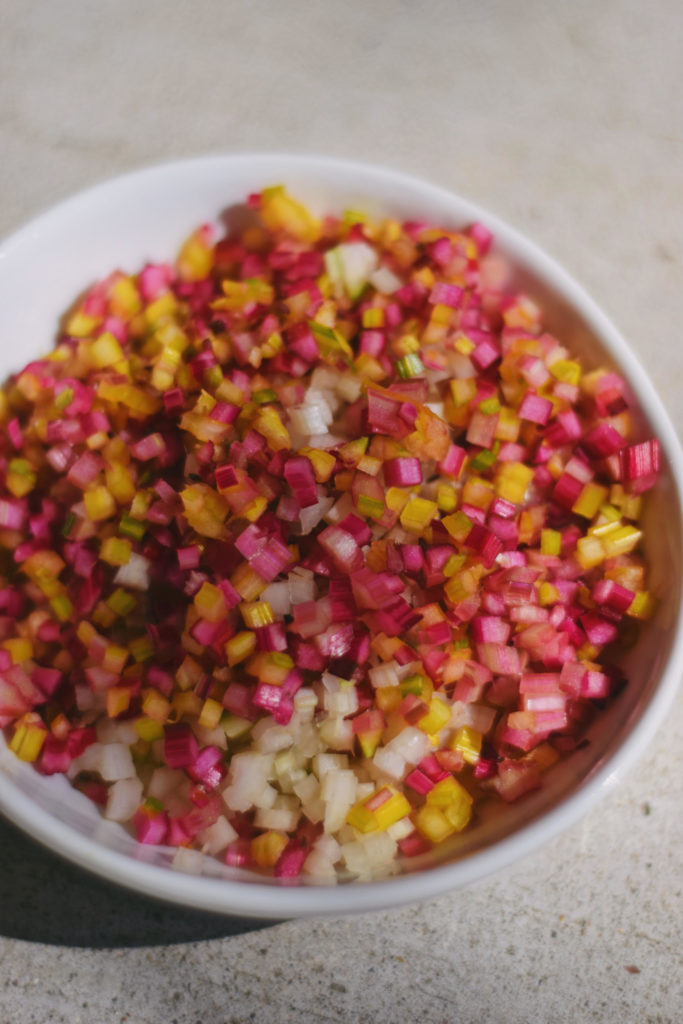
Ingredients:
- 1 Bunch Rainbow or Swiss Chard
- 1 Tablespoon Olive Oil
- 1 Pound Lean Ground Beef
- 1/2 Medium Yellow Onion, Diced
- 2 Jalapenos, Diced
- 3 Cloves Garlic, Minced
- 1 8 ounce Can Tomato Sauce
- 1 14.5 ounce Can Diced Tomatoes
- 3 Chipotle Chilies in Adobo
- 1/2 Teaspoon Cumin
- 1/2 Teaspoon Oregano
- 1 Teaspoon Paprika
- 1 Pinch Cayenne
- Salt to taste
- 1/2 Cup Cotija Cheese or Queso Fresco
- 1/4 Cup Fresh Cilantro, Chopped
Instructions:
Bring a large pot of water to a boil and prepare an ice bath (add ice and water to a large mixing bowl).Cut the stems off your chard leaves, dice them and set them aside. We will be cooking these with the filling.
Blanch each leaf for 1-2 seconds in the boiling water and place into the ice bath. Blanching the leaves helps to make them easier to roll.
Next, make the enchilada sauce. Add the diced tomatoes, tomato sauce, chipotle chilies with some of the chipotle sauce, and 1 garlic clove to a food processor or blender. Pulse until smooth. Add salt and pepper to taste and set aside.
Preheat oven to 350F
Add 1 tablespoon olive oil to a large saucepan over medium heat.
Add the onions, jalapenos, and 2 cloves garlic. Let cook for about 2-3 minutes or until softened.
Add the ground beef next, using the back of a wooden spoon to break it up and brown.
Once the meat has cooked through, add in the diced chard stems, and the spices - paprika, cumin, oregano, cayenne, and about 1 teaspoon of salt. Stir to combine.
Next, add in about 4 tablespoons of the sauce you had set aside and combine well. Cook for about 5-7 minutes and then remove from heat.
Add 3-4 tablespoons of your sauce to the bottom of a baking dish (we used an 8.5" by 11" dish) to prevent sticking.
Add a few spoonfuls (amount will vary depending on the size of your leaves) of filling to the center of your chard leaf. Fold in the sides and gently roll up, like a burrito. Place into baking dish. Continue until you have used all of your leaves.
Pour remaining sauce over the top and bake at 350F for about 10 minutes.
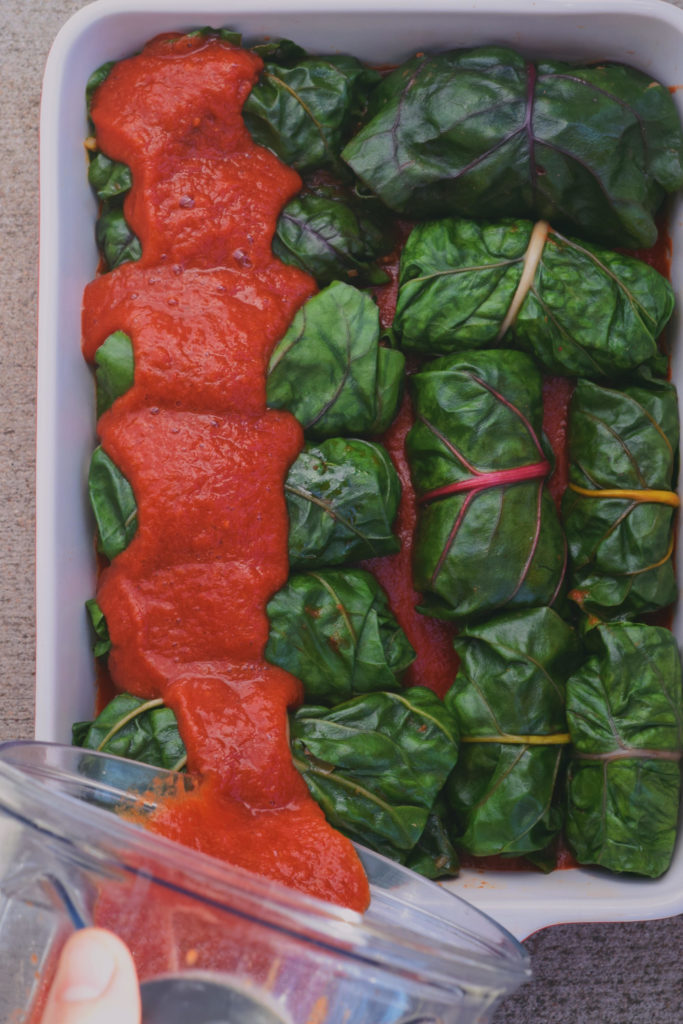
Remove enchiladas from the oven and top with your cotija cheese or queso fresco and bake for another 10 minutes.
Top with fresh cilantro and any other of your favorite toppings such as sour cream, avocado, and sliced jalapenos!
CSA BOX CONTENTS WEEK OF FEB 25TH
02/26/19 — Scott
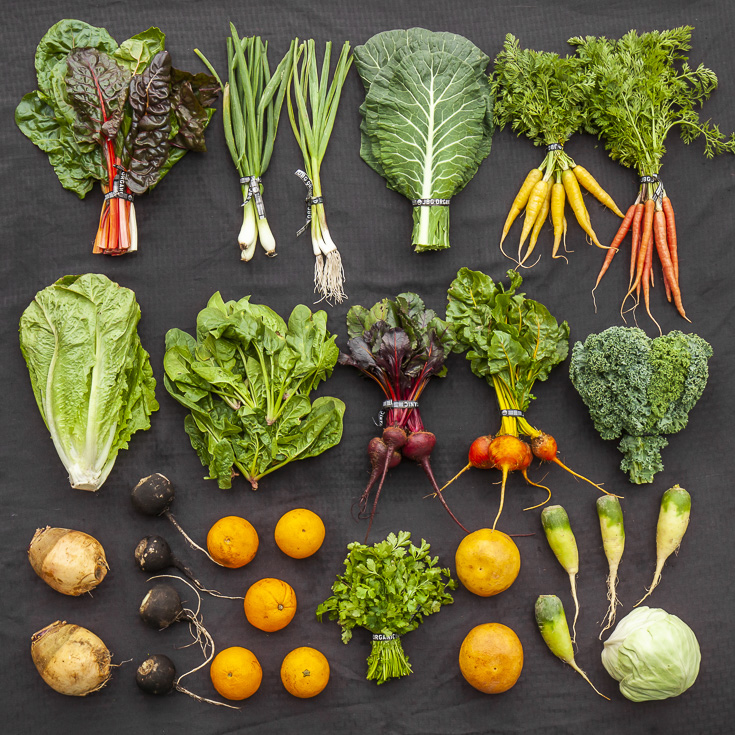 CSA Box Contents Week of Feb 25th
CSA Box Contents Week of Feb 25th
Large Box
Beet, Red
Brussels Sprouts
Cabbage
Carrots
Garlic, Green
Greens, Chard, Rainbow
Greens, Collards
Greens, Kale, Dino
Greens, Spinach
Lettuce, Romaine
Onion, Spring White
Radish, Purple Daikon
Turnip, Purple Top
Beet, Red
Brussels Sprouts
Cabbage
Carrots
Garlic, Green
Greens, Chard, Rainbow
Greens, Collards
Greens, Kale, Dino
Greens, Spinach
Lettuce, Romaine
Onion, Spring White
Radish, Purple Daikon
Turnip, Purple Top
Medium Box
Beet, Red
Brussels Sprouts
Carrots
Garlic, Green
Greens, Chard, Rainbow
Greens, Kale, Dino
Lettuce, Romaine
Onion, Spring White
Radish, Purple Daikon
Turnip, Purple Top
Beet, Red
Brussels Sprouts
Carrots
Garlic, Green
Greens, Chard, Rainbow
Greens, Kale, Dino
Lettuce, Romaine
Onion, Spring White
Radish, Purple Daikon
Turnip, Purple Top
Small Box
Beet, Red
Carrots
Greens, Collards
Greens, Kale, Curly
Herb, Cilantro
Lettuce, Romaine
Radish, Green Daikon
Beet, Red
Carrots
Greens, Collards
Greens, Kale, Curly
Herb, Cilantro
Lettuce, Romaine
Radish, Green Daikon
Individual Box
Carrots
Greens, Kale, Curly
Lettuce, Romaine
Onion, Spring White
Radish, Green Daikon
Carrots
Greens, Kale, Curly
Lettuce, Romaine
Onion, Spring White
Radish, Green Daikon
A FARMER'S GUIDE TO A DAY TRIP TO GARFIELD, TEXAS
02/22/19 — Heydon Hatcher
It’s here! The first weekend of our three-weekend transplant sale is tomorrow, Saturday the 23rd! We will have our most varied selection of certified-organic transplants yet at this greenhouse sale. Our Garfield farm is located at 4008 River Road, Garfield, 78512, and we will be there from 9 am to 2 pm slinging the baby crops. Come and get ‘em! There will also be a selection of organic compost, soil amendments, and farm-grade tomato cages and stakes for that stellar spring garden you have in mind.
We know that Garfield can seem a little out of the way for you Central Austinites, but we say, make a day of it! It’ll be worth it when you have a car full of smiles, a full belly, and a trunk full of transplants for your most glorious spring garden yet. Here’s our farmers’ guide to a day trip to Garfield, Texas. Check it out.
![]() Transplant loot. Photo by Scott David Gordon.
Transplant loot. Photo by Scott David Gordon.
![]() Colorado River. Photo by Tamir Kalifa.
Colorado River. Photo by Tamir Kalifa.
![]() Texas Reptile Zoo. Photo courtesy of the Texas Reptile Zoo on Pinterest.
Texas Reptile Zoo. Photo courtesy of the Texas Reptile Zoo on Pinterest.
If you keep heading east to Bastrop proper, we’re told that Maxine’s Cafe and Bakery has the best breakfast in Bastrop. Our head farmer loves to take folks to Roadhouse for drool-worthy burgers after a hard day of farming. They sure are inimitably tasty. If you love live tunes, amazingly delicious food from scratch, and dazzling views of the Colorado River, head to Neighbor’s Kitchen and Yard. It’s a breath of fresh air from the big city. If it’s a beautiful day, sit on the deck. You won’t regret it. Finally, to satiate that sweet tooth, head to Berdoll Pecan Farm for their endless pecans, pecan pie vending machine, and a photo opportunity with the giant squirrel statue!
![]() Neighbor's Bar. Photo courtesy of the Neighbor's website.
Neighbor's Bar. Photo courtesy of the Neighbor's website.
Come to our transplant sale and explore Texas this weekend! See you soon!
We know that Garfield can seem a little out of the way for you Central Austinites, but we say, make a day of it! It’ll be worth it when you have a car full of smiles, a full belly, and a trunk full of transplants for your most glorious spring garden yet. Here’s our farmers’ guide to a day trip to Garfield, Texas. Check it out.
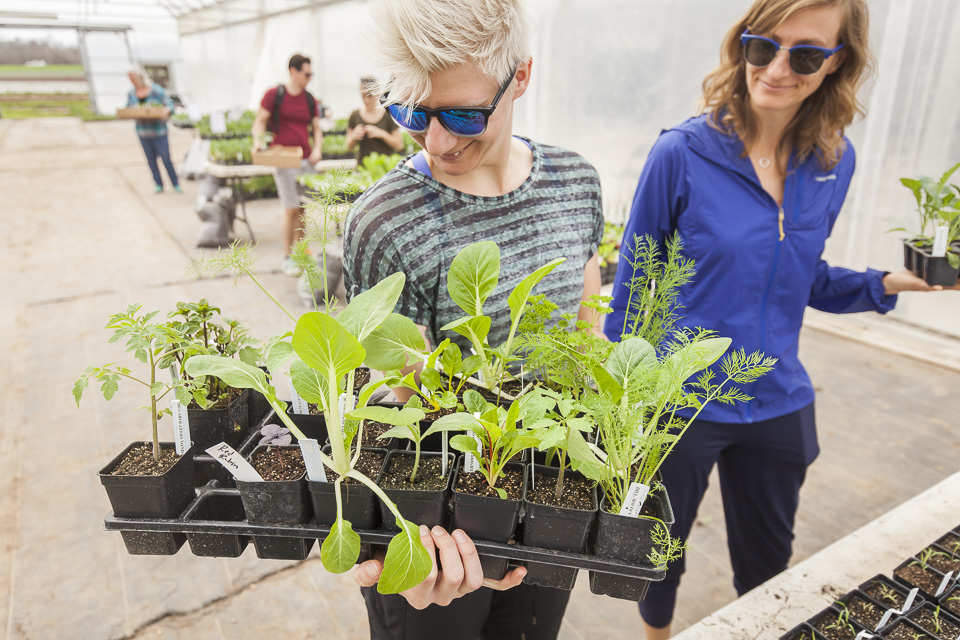 Transplant loot. Photo by Scott David Gordon.
Transplant loot. Photo by Scott David Gordon.
Get your outdoor fix with the fam!
Head to one of the many outdoor oases east of the airport. McKinney Roughs Nature Park offers multi-use trails, picnic spots, and legendary ziplines! After wildfire damage in recent years, Bastrop State Park has no shortage of new growth to ogle. Witness the rebirth of this marvelous state park through hiking, camping, biking, or any number of outdoor activities, and marvel the start of the notorious East Texas Lost Pines Forest. The Colorado River Refuge and the Lost Pines Nature Trails both offer a quiet respite from city living with tons of amazing views and trails adjacent to the Colorado River (the same river that runs through our farm!). Keen on fishing? Check out Lake Bastrop for some serious largemouth bass, sunfish, catfish, and crappie loot. Not to mention, Lake Bastrop South Shore Park is the cornerstone for all water, outdoor, and camping activities in Bastrop proper.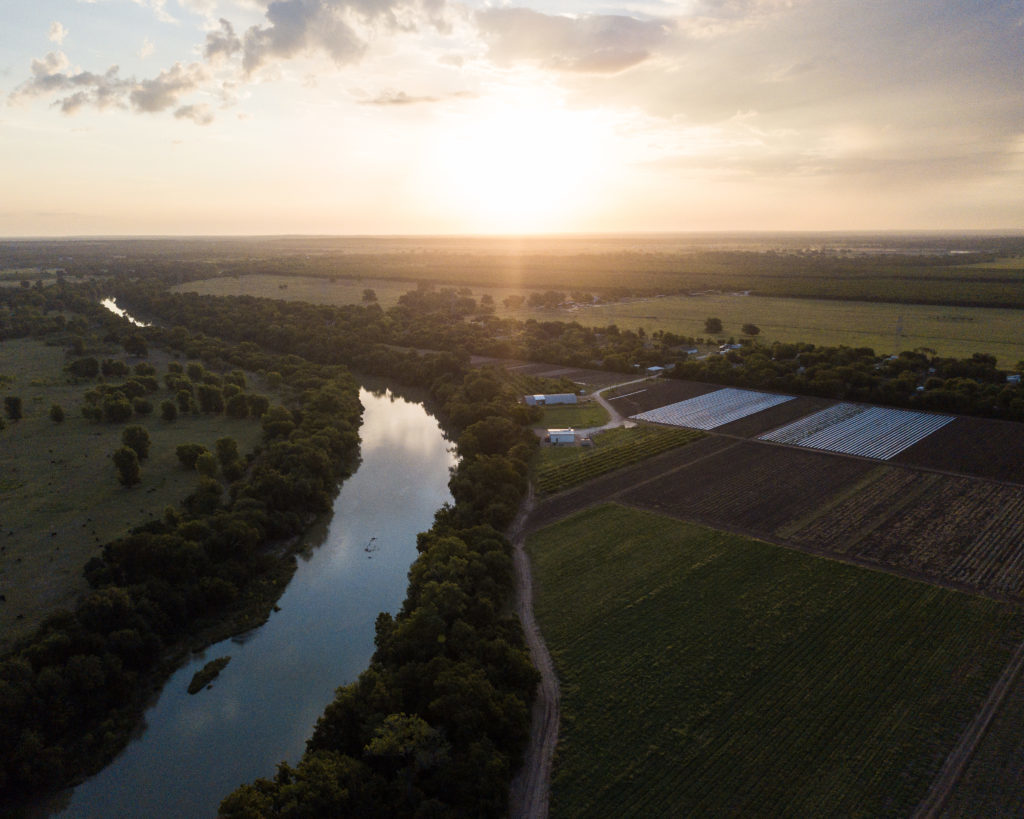 Colorado River. Photo by Tamir Kalifa.
Colorado River. Photo by Tamir Kalifa.
Got animal lovers in the family?
How about hopping over to the Texas Reptile Zoo for a very unique reptile experience. However, if reptiles aren’t your cup of tea, how about the Capital of Texas Zoo? It's a one-of-a-kind private wildlife park that houses a vast array of animals and tons of educational opportunities.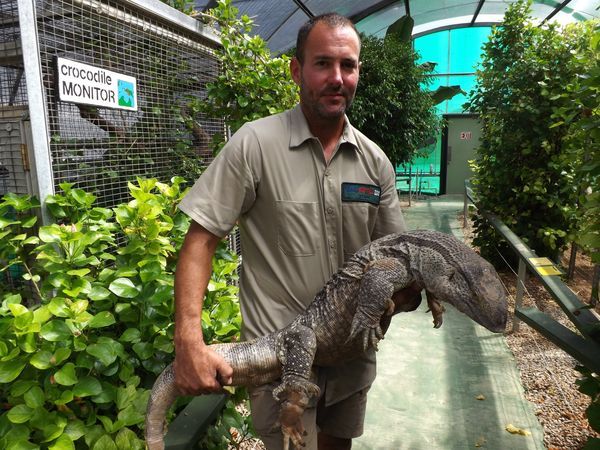 Texas Reptile Zoo. Photo courtesy of the Texas Reptile Zoo on Pinterest.
Texas Reptile Zoo. Photo courtesy of the Texas Reptile Zoo on Pinterest.
Got food on the mind?
A local favorite that has recently been revamped is Little Thailand and said to have the best Thai food in central Texas. The recently passed original owners’ niece and nephew have reopened, reenergized, and reinvigorated the place with the warmth for which it's notorious. Located underneath the Garfield water tower, it’s proximity to JBG begs for a quick stop to eat some spicy dishes, and while you’re at it, stop by the Garfield Library to grab some books! If you are jonesin’ for a quick beverage of the alcoholic sort, stop by the Waterhole Saloon across the street, a historic neighborhood bar with an outdoor stage that is said to feel like old Austin.If you keep heading east to Bastrop proper, we’re told that Maxine’s Cafe and Bakery has the best breakfast in Bastrop. Our head farmer loves to take folks to Roadhouse for drool-worthy burgers after a hard day of farming. They sure are inimitably tasty. If you love live tunes, amazingly delicious food from scratch, and dazzling views of the Colorado River, head to Neighbor’s Kitchen and Yard. It’s a breath of fresh air from the big city. If it’s a beautiful day, sit on the deck. You won’t regret it. Finally, to satiate that sweet tooth, head to Berdoll Pecan Farm for their endless pecans, pecan pie vending machine, and a photo opportunity with the giant squirrel statue!
 Neighbor's Bar. Photo courtesy of the Neighbor's website.
Neighbor's Bar. Photo courtesy of the Neighbor's website.
Come to our transplant sale and explore Texas this weekend! See you soon!
BRAISED COLLARDS & POACHED EGGS
02/21/19 — Heydon Hatcher
Recipe and Photos by Megan Winfrey
Breakfast greens. Ever heard of 'em? A side of leafy vegetables with breakfast is one of my favorite things, and it's a great way to get an extra helping of nutrients into your day. This one-pan-wonder meal is a hit in my household, even with the almost four-year-old. Collards can be replaced with any type of chard, kale, or even cabbage. Try adding beans, diced tomatoes, and a tablespoon or two of cumin for a Mexican flare - this dish is highly customizable! In whatever direction you go with this recipe, buttered toast is a must.
![]()
Braised Collards & Poached Eggs![]()
Over medium-high, heat a large cast iron or heavy bottomed skillet. Cook the bacon until crispy, then set aside to drain on a towel. Reduce the heat to medium-low and cook the onion and garlic until tender and translucent. Add half of the collards to the pan and let wilt for about 2 minutes before adding the other half. Cook until all of the greens are wilted, but still a bright green color. Stir in the lime juice and chicken broth, and crank the heat back up to medium-high. Create a pocket in the greens for each egg, then add a slice of butter to each pocket. Crack an egg into each of the pockets and sprinkle salt and pepper over each, to taste. Cover and simmer until the egg whites are cooked, and the yolks are cooked to your liking. I over poached them slightly as to avoid a runny yolk meltdown from the tiny human. Once the eggs are done, scatter crumbled bacon over the top and serve! Add some shredded cheese or serve over grits, but don't forget the buttered toast for sopping up that golden yolk.
Breakfast greens. Ever heard of 'em? A side of leafy vegetables with breakfast is one of my favorite things, and it's a great way to get an extra helping of nutrients into your day. This one-pan-wonder meal is a hit in my household, even with the almost four-year-old. Collards can be replaced with any type of chard, kale, or even cabbage. Try adding beans, diced tomatoes, and a tablespoon or two of cumin for a Mexican flare - this dish is highly customizable! In whatever direction you go with this recipe, buttered toast is a must.
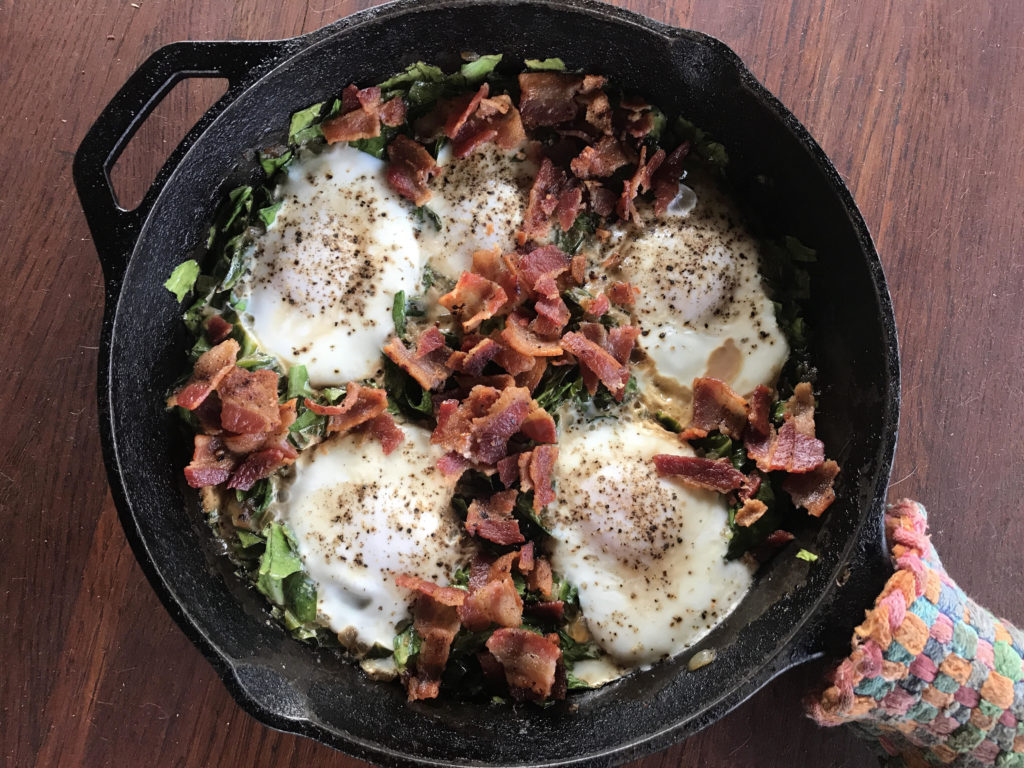
Braised Collards & Poached Eggs
- 1 bunch collard greens, stems removed and chopped
- 6 slices of bacon
- 1 medium onion, chopped
- 3 cloves garlic, diced
- 1 tbs. lime juice
- 1/2 cup chicken stock
- 3-6 eggs (depending on how many will be eaten)
- butter
- salt and pepper to taste
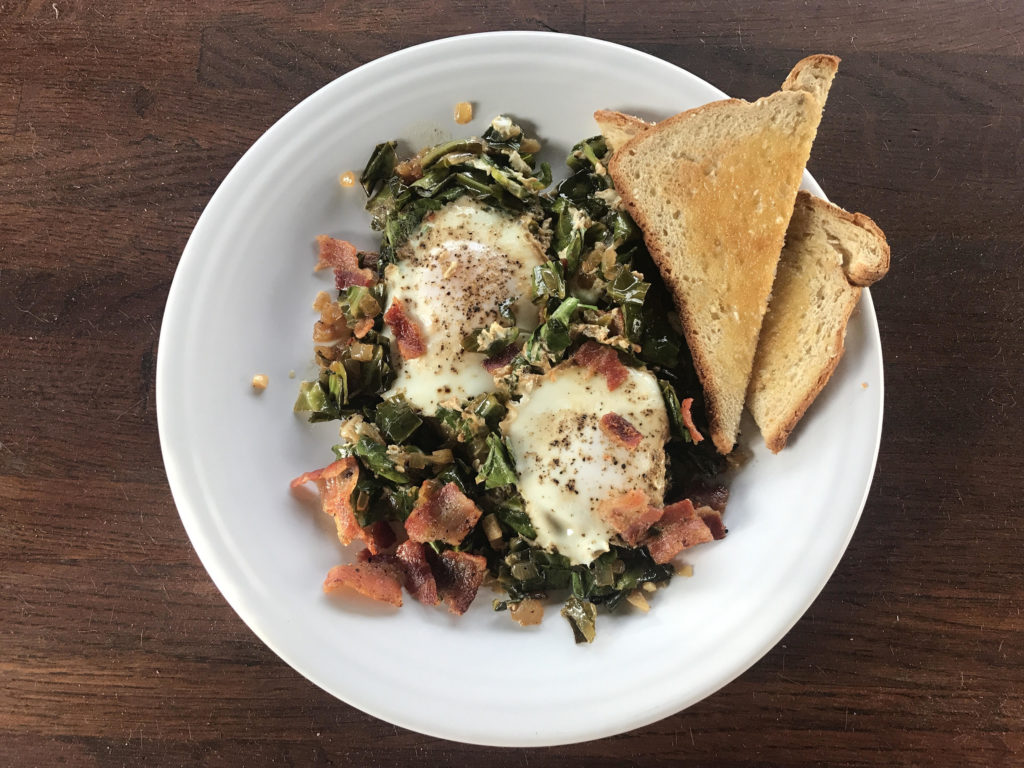
Over medium-high, heat a large cast iron or heavy bottomed skillet. Cook the bacon until crispy, then set aside to drain on a towel. Reduce the heat to medium-low and cook the onion and garlic until tender and translucent. Add half of the collards to the pan and let wilt for about 2 minutes before adding the other half. Cook until all of the greens are wilted, but still a bright green color. Stir in the lime juice and chicken broth, and crank the heat back up to medium-high. Create a pocket in the greens for each egg, then add a slice of butter to each pocket. Crack an egg into each of the pockets and sprinkle salt and pepper over each, to taste. Cover and simmer until the egg whites are cooked, and the yolks are cooked to your liking. I over poached them slightly as to avoid a runny yolk meltdown from the tiny human. Once the eggs are done, scatter crumbled bacon over the top and serve! Add some shredded cheese or serve over grits, but don't forget the buttered toast for sopping up that golden yolk.
CSA BOX CONTENTS WEEK OF FEB 18TH
02/19/19 — Scott
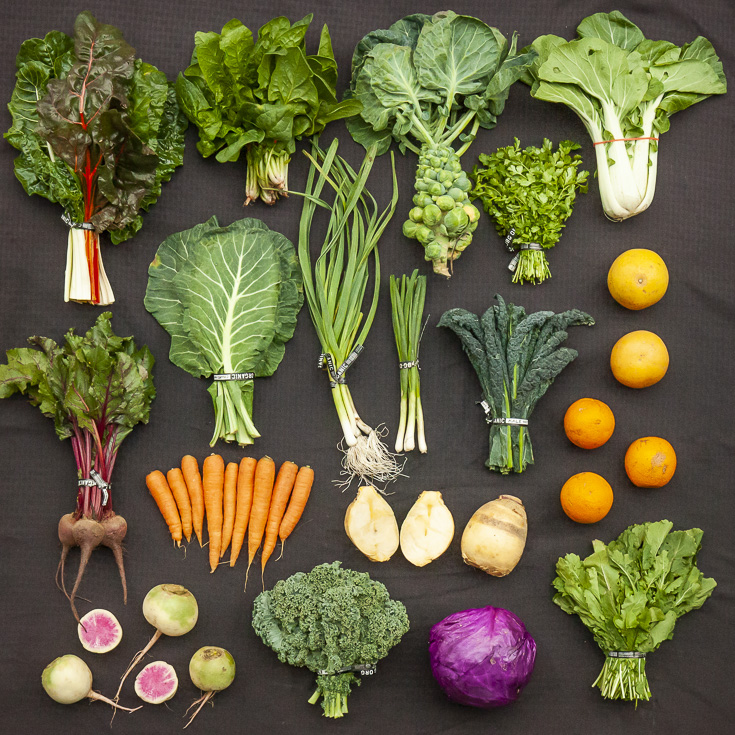 CSA Box Contents Week of Feb 18th
CSA Box Contents Week of Feb 18th
Large Box
Beet, Golden
Cabbage
Carrot, Rainbow
Citrus, Mixed
Garlic, Green
Greens, Chard, Rainbow
Greens, Collards
Greens, Kale, Curly
Lettuce, Mixed head bag
Onion, Spring White
Radish, Black Spanish
Turnip, Rutabaga
Beet, Golden
Cabbage
Carrot, Rainbow
Citrus, Mixed
Garlic, Green
Greens, Chard, Rainbow
Greens, Collards
Greens, Kale, Curly
Lettuce, Mixed head bag
Onion, Spring White
Radish, Black Spanish
Turnip, Rutabaga
Medium Box
Beet, Red
Cabbage
Carrot, Orange
Greens, Collards
Greens, Kale, Curly
Greens, Salad Mix
Herb, Cilantro
Onion, Spring White
Radish, Black Spanish
Turnip, Rutabaga
Beet, Red
Cabbage
Carrot, Orange
Greens, Collards
Greens, Kale, Curly
Greens, Salad Mix
Herb, Cilantro
Onion, Spring White
Radish, Black Spanish
Turnip, Rutabaga
Small Box
Carrot, Rainbow
Garlic, Green
Greens, Chard, Rainbow
Greens, Kale, Curly
Lettuce, Mixed head bag
Onion, Spring White
Turnip, Rutabaga
Carrot, Rainbow
Garlic, Green
Greens, Chard, Rainbow
Greens, Kale, Curly
Lettuce, Mixed head bag
Onion, Spring White
Turnip, Rutabaga
Individual Box
Beet, Red
Carrot, Orange
Greens, Collards
Greens, Salad Mix
Onion, Spring White
Beet, Red
Carrot, Orange
Greens, Collards
Greens, Salad Mix
Onion, Spring White
FROM THE FARMER'S PERSPECTIVE: BRENTON GOES TO THE 2019 WORLD AG EXPO
02/15/19 — Heydon Hatcher
Hello from Tulare, California! I’m here for the 2019 World Ag Expo. It’s the largest annual exposition for agriculture in the world... there are more than 1,500 exhibitors showcasing innovative technology and equipment on 2.6 million square feet of land! Last year, folks traveled from 49 states and 63 countries to attend. I’m here with farm efficiency on the mind. It’s been 3 days of exploration and excitement. I arrived in Los Angeles Monday night at 10 PM, then hopped in the rental car and drove to Bakersville to stay for the evening. I woke up at 5 am the following morning to have a JBG operations meeting from my hotel room, then finished the journey north to Tulare, a town located in the heart of the Central Valley and home of the World Ag Expo. I drove to Expo headquarters and, with jaw dropped, I surveyed the biggest parking lot and the most buses I have ever seen in my life.
![]() Photo courtesy of the World Ag Expo.
Photo courtesy of the World Ag Expo.
I walked into the first gate I saw, like a deer in headlights, and was drawn immediately to an importer of specialty equipment from Italy. I was there talking for at least 3 hours to the engineers of the products if you can believe it. When I started JBG in my backyard and did everything by hand, there weren’t many farmers around that utilized tractors or other larger farm equipment; thus, I had to learn everything farm equipment-related via YouTube and internet search rabbit holes. When I visit neighboring farms in Texas and neighboring states, I always learn something new; however, at this expo, you are sharing information with people from all over the world who might (and probably) farm completely different from you, as well as seeing first hand the most cutting edge agricultural technology. It’s amazing and mind expanding.
![]()
![]()
![]() Photos from the Expo!
Photos from the Expo!
I’ve been looking at our whole production system, or how we make a crop from start to finish, and brainstorming on how and where to improve operations in order to make things easier for everyone at JBG. For example, every time a tractor drives over soil, the soil compacts and compresses into a smaller volume, making it difficult for air, water, and roots to penetrate. This is soil degradation and obviously not ideal for the crops' growth. However, if you slap a GPS on the tractor, the machine will only drive on designated little paths every pass and keep the beds soft and lush for crops. Plus, the beds would stay in the same place instead of moving around on the acreage. This is called control traffic farming and is something I read about in college 20 years ago. With technology improving, the cost of this pioneering equipment has dropped immensely, making easy technological improvements more accessible to farmers. Another example where implements could help us is reducing passes. We make anywhere from nine to twelve passes when preparing the crop bed currently, depending on soil conditions. However, using combination tools, where you can add implements to the front and back of a tractor, we could prepare the bed in as little as two passes. This could reduce our fuel usage by 500 or 600% which is beneficial for the environment and saves us a little cash, too.
![]() My list of our production system and where to improve.
My list of our production system and where to improve.
All of these innovations reduce our labor requirements, and since we never have a shortage of work to do at the farm, we could send farmers to tackle other more pressing tasks. Weed elimination and harvesting would most likely be at the top of that list if we were hypothetically to get a bunch of fancy new equipment today. So, here’s to finding new and fun solutions to all of our problems in farming and in life! ‘Til next time.
 Photo courtesy of the World Ag Expo.
Photo courtesy of the World Ag Expo.
I walked into the first gate I saw, like a deer in headlights, and was drawn immediately to an importer of specialty equipment from Italy. I was there talking for at least 3 hours to the engineers of the products if you can believe it. When I started JBG in my backyard and did everything by hand, there weren’t many farmers around that utilized tractors or other larger farm equipment; thus, I had to learn everything farm equipment-related via YouTube and internet search rabbit holes. When I visit neighboring farms in Texas and neighboring states, I always learn something new; however, at this expo, you are sharing information with people from all over the world who might (and probably) farm completely different from you, as well as seeing first hand the most cutting edge agricultural technology. It’s amazing and mind expanding.


 Photos from the Expo!
Photos from the Expo!
I’ve been looking at our whole production system, or how we make a crop from start to finish, and brainstorming on how and where to improve operations in order to make things easier for everyone at JBG. For example, every time a tractor drives over soil, the soil compacts and compresses into a smaller volume, making it difficult for air, water, and roots to penetrate. This is soil degradation and obviously not ideal for the crops' growth. However, if you slap a GPS on the tractor, the machine will only drive on designated little paths every pass and keep the beds soft and lush for crops. Plus, the beds would stay in the same place instead of moving around on the acreage. This is called control traffic farming and is something I read about in college 20 years ago. With technology improving, the cost of this pioneering equipment has dropped immensely, making easy technological improvements more accessible to farmers. Another example where implements could help us is reducing passes. We make anywhere from nine to twelve passes when preparing the crop bed currently, depending on soil conditions. However, using combination tools, where you can add implements to the front and back of a tractor, we could prepare the bed in as little as two passes. This could reduce our fuel usage by 500 or 600% which is beneficial for the environment and saves us a little cash, too.
 My list of our production system and where to improve.
My list of our production system and where to improve.
All of these innovations reduce our labor requirements, and since we never have a shortage of work to do at the farm, we could send farmers to tackle other more pressing tasks. Weed elimination and harvesting would most likely be at the top of that list if we were hypothetically to get a bunch of fancy new equipment today. So, here’s to finding new and fun solutions to all of our problems in farming and in life! ‘Til next time.






 0 ITEMS IN CART
0 ITEMS IN CART 

